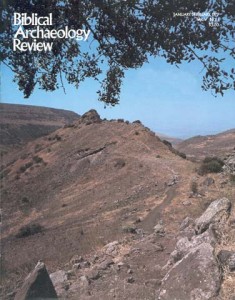Biblical Archaeology Review, January/February 1979
Features
Gamla: the Masada of the North
Gamla has been found. Israelis are calling it the Masada of the north. Masada, south of Jerusalem in the Judean wilderness, was the last Jewish outpost to fall to the Romans thus ending, in 73 A.D., the First Jewish Revolt against Rome. Jews at Masada committed suicide...Read more ›
The Fall of Gamla
By 67 A.D. a general rebellion against Rome engulfed Palestine. Jerusalem had repulsed a Roman attack and the Jews had set up their own government which divided the country into seven military districts, each with its own commander. The Galilee command fell to a...Read more ›
“In Pain Shalt Thou Bring Forth Children”
“So far as I know,” writes Carl Sagan, author of The Dragons of Eden—Speculations on the Evolution of Human Intelligence,a “childbirth is generally painful in only one of the millions of species on Earth: human beings.” This is because of the comparatively large human skull, which, in...Read more ›
Free to BAR Subscribers: 30-Year Survey of Biblical Archaeology
“Biblical Archaeology After 30 Years (1948–1978)” is the title of a lecture delivered by Siegfried H. Horn, Dean Emeritus of Andrews University, at the recent dedication of the Horn Archaeological Museum located on the campus at Berrien Springs, Michigan. As a special bonus to its readers, BAR...Read more ›
The World’s First Museum and the World’s First Archaeologists
In 1160 B.C., Shutruk-Nahhunte, King of Elam in the mountains east of Mesopotamia, campaigned triumphantly through Agade, Kish, Sippar, and other towns of ancient Babylonia. He returned to his capital at Susa with a rich haul of loot, which he offered up to the god who had...Read more ›
BAR Readers to Restore Israelite Village from the Days of the Judges
BAR’s Archaeological Preservation Fund has agreed to preserve and restore the site of Izbet Sartah. Many scholars believe Izbet Sartah is Biblical Ebenezer, where the Israelites mustered for a critical battle with the Philistines in the days of the Judges (see 1 Samuel 4)...Read more ›
Phoenicians in Brazil?
Distinguished linguist examines controversial inscription supposedly written by ancient voyagers to the New World.
Of the recurring, often bizarre attempts to find ancient Semitic inscriptions in the western hemisphere, the most prominent and frequently cited concerns the so-called Paraiba inscription from Brazil. The Paraiba inscription is said to be a Phoenician inscription carved in stone and found in...Read more ›

